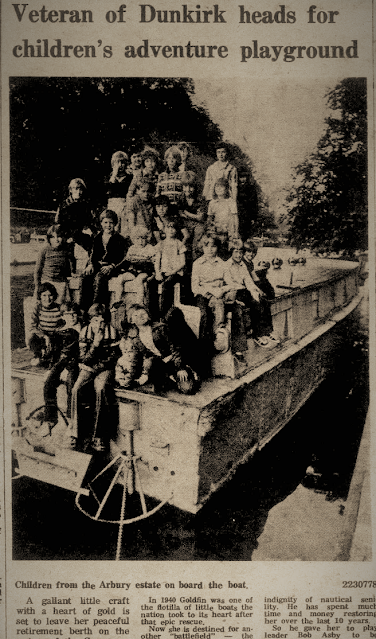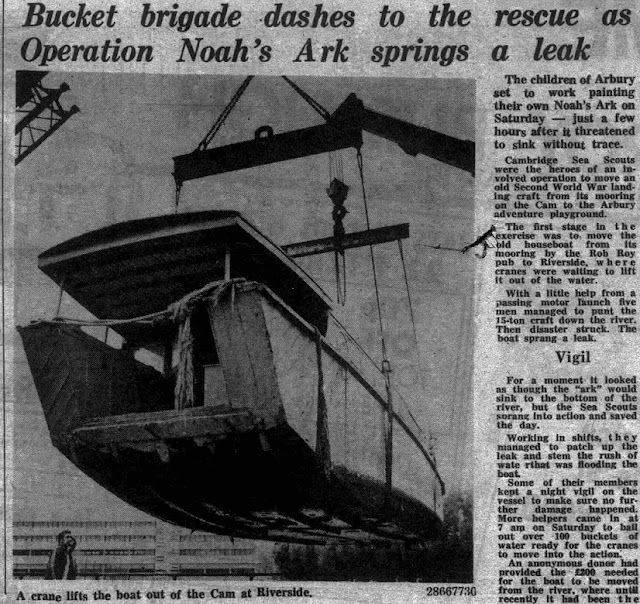Thanks to Mrs Summers who sent us this Cambridge Evening News article about an exciting addition to the Arbury Adventure Playground on the Nuns Way Playing Field from August 1977.
Veteran of Dunkirk Heads for Children's Adventure Playground
A gallant little craft with a heart of gold is set to leave her peaceful retirement berth on the waters of the Cam.
She is not exactly beautiful, but to shell-shocked troops on the wartime Dunkirk beaches she was the answer to a prayer.
In 1940, Goldfin was one of the flotilla of little boats the nation took to its heart after that epic rescue.
Now she is destined for another "battleground" - the Arbury Adventure Playground in Cambridge.
Her owner, Mr Jeffrey Perkins, couldn't bear the thought of his former personal carrier suffering the indignity of nautical senility. He has spent much time and money restoring her over the last ten years.
So he gave her to play leader Bob Asby to be brought back to life by the under-fives [under fifteens?] of the Arbury Estate.
There is, however, a problem. Goldfin is forty feet long, eight feet wide and weighs fifteen tons - and Bob can't find a crane big enough to lift her out of the water.
"Even one of those giant American Airforce helicopters would find her a bit of a handful," he said yesterday.
"The kids have set their hearts on her - they have already decided she would make a first class Noah's Ark."
Goldfin did make it to the Adventure Playground. One of the child contributors to the Arbury 1980 project and the 1981 Arbury Is Where We Live! book wrote about a visit to the playground:
In the playground there was an old wooden warship, from the Second World War. It was lifted off the River Cam by a crane on to the back of a lorry which drove to the playground.
From 'Arbury Is Where We Live!' - 1981. No sooner had we uploaded this, than Paul Miller, a former North Arbury resident, sent us the October 1977 'Cambridge Evening News' article below, which details the eventful removal of the boat to the Adventure Playground.
Bucket brigade dashes to the rescue as Operation Noah's Ark springs a leak
The children of Arbury set to work painting their own Noah's Ark on Saturday - just a few hours after it threatened to sink without trace.
Cambridge Sea Scouts were the heroes of an involved operation to move an old Second World War landing craft from its mooring on the Cam to the Arbury Adventure Playground.
The first stage in the exercise was to move the old houseboat from its mooring by the Rob Roy pub to Riverside, where cranes were waiting to lift it out of the water.
With a little help from a passing motor launch five men managed to punt the 15-ton craft down the river. Then disaster struck - the boat sprang a leak.
For a moment it looked as though the "ark" would sink to the bottom of the river. But the Sea Scouts sprang into action and saved the day.
Working in shifts, they managed to patch up the leak and stem the rush of water that was flooding the boat.
Some of their members kept a night vigil on the vessel to make sure no further damage happened.
More helpers came in at 7am on Saturday to bail out over 100 buckets of water ready for the cranes to move into the action.
An anonymous donor had provided the £200 needed for the boat to be moved from the river where, until recently, it had been the home of Mr Jeffrey Perkins.
There was only one more hitch. The trailer would not fit through the fence around the playground, which had to be dug up by volunteers before the boat could be moved into place.
By midday it was at rest in the playground and children were already at work sanding it down and painting it.
The play leader Mr Bob Asby said, "The kids are absolutely overwhelmed and I'm sure it will be a fantastic success."
One of his plans is to keep it as a sort of Arbury Noah's Ark, but it will have to be on a modest scale to start with - at present the playground can only boast two rabbits and a chicken.
Of course, it wouldn't be long before the Arbury Noah's Ark could boast its very own Arbury goat!
UPDATED 09/04/25






Hello Arbury Archivists. How are you today? Will you be doing more on the Arbury Adventure Playground because it was fab?
ReplyDeleteWe're OK thanks - and hello to you too. Thanks for writing. Yes, more Arbury Adventure Playground coming soon.
Delete